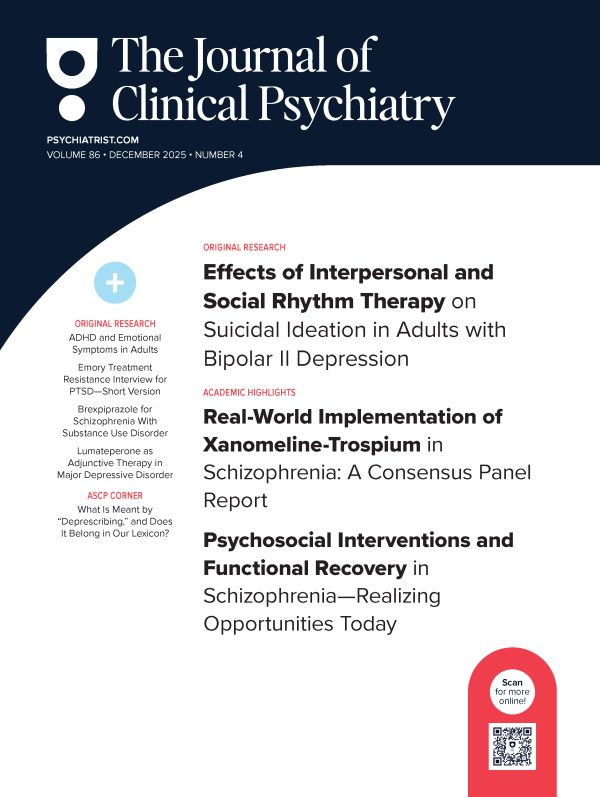Impact of Burnout Syndrome on Gastroesophageal Reflux Disease and Irritable Bowel Syndrome in Health Care Workers
To the Editor: We read with great interest the review by Culpepper1 regarding the association between anxiety and medical illnesses such as peptic ulcer disease and irritable bowel syndrome (IBS).1 Recently, we evaluated the impact of burnout syndrome on functional gastrointestinal (GI) disorders in all health care workers who work at our hospital.
Method. The sample consisted of 144 subjects, 52 men, with a mean ± SD age of 39 ± 9 years. The study was conducted from February 1, 2009, to April 30, 2009. Declaration of Helsinki guidelines were followed.
In each worker, the Maslach Burnout Inventory2 was used to detect and measure the severity of burnout syndrome, which is a psychological state resulting from prolonged exposure to job stressors. The Maslach Burnout Inventory evaluates 3 burnout syndrome domains, namely, emotional exhaustion, loss of a feeling of personal accomplishment at work, and depersonalization (negative or cynical attitudes toward patients).2 The questionnaire is composed of 22 items that measure the 3 burnout components by eliciting one of the following responses in terms of frequency, ranging from 0 to 6: 0 = never, 1 = few times a year, 2 = once a month, 3 = few times a month, 4 = once a week, 5 = few times a week, 6 = every day. Each statement on the questionnaire pertains to one of the 3 subscales mentioned (9 statements for emotional exhaustion, 8 for feeling of personal accomplishment, and 5 for depersonalization).
On the subscales for emotional exhaustion and depersonalization, high scores correspond to increased levels of feeling "burned out," while on the personal accomplishment scale, low scores indicate an increased level of feeling "burned out." Thus, participants were defined as positive for emotional exhaustion if they had a score ≥ 27, depersonalization if they had a score ≥ 10, and loss of a feeling of personal accomplishment if they had a score ≤ 30. Although there is no consensus for evaluation of a total burnout score, we have adopted the criteria proposed by Grunfeld et al.3 On the basis of these criteria, the burnout syndrome is deemed present if at least 1 of the dimensions is severely abnormal (emotional exhaustion ≥ 27, depersonalization ≥ 14, or loss of a feeling of personal accomplishment ≤ 30).
In addition, at the same time, the following data were recorded: (1) demographic, clinical, and laboratory data, including smoking and alcohol status, coffee consumption, educational level, chronic and temporary drug use (eg, nonsteroidal anti-inflammatory drugs, aspirin), and body mass index; (2) the presence of upper and lower GI symptoms, such as gastroesophageal reflux disease (GERD) and IBS, using a well-established questionnaire, the Gastrointestinal Symptom Rating Scale (GSRS),4 which was translated into Greek many years ago with the approval of the GSRS makers and has been used in Greek patients for diagnosis and evaluation of severity of GI disorders; and (3) coexisting diseases (eg, diabetes mellitus, arterial hypertension, and coronary artery disease [CAD]).
All questionnaires were completed during face-to-face interviews. All data were analyzed using the statistical package SPSS (version 13.0; SPSS Inc, Chicago, Illinois). The χ2 test was used for categorical variables, and the Mann-Whitney U test was used for comparing quantitative continuous variables.
Results. We found that 101 (70.1%) of 144 workers fulfilled the criteria for burnout syndrome. In addition, 15 (10.4%), 107 (74.3%), and 7 (4.9%) workers suffered from emotional exhaustion, loss of a feeling of personal accomplishment, and depersonalization, respectively. The health care workers with burnout syndrome, compared to those without burnout syndrome, had similar demographic and clinical characteristics, but burnout syndrome was significantly associated with the presence of CAD and arterial hypertension (P = .022 and .05, respectively). In addition, 61 (42%) workers reported at least 1 monthly episode of GERD, ie, the presence of heartburn and/or regurgitation; the latter defined as rumination, which is the involuntary regurgitation of small amounts of food from the stomach a few minutes after eating that are rechewed and, in most cases, again swallowed with no nausea or abdominal pain, during the last 6 months. The workers with burnout syndrome, compared to those without burnout syndrome, significantly more frequently had ulcer-like pain (13% vs 0%, respectively; P = .001) and dyspepsia (28% vs 12%, P = .021). The workers with emotional exhaustion, compared to those without emotional exhaustion, significantly more frequently had nausea (50% vs 25%, P = .04) and heartburn (74% vs 45%, P = .03). In addition, men with emotional exhaustion, compared to men without emotional exhaustion, more frequently had regurgitation (50% vs 35%, P = .021). Moreover, the workers with loss of a feeling of personal accomplishment, compared to those without loss of a feeling of personal accomplishment, more frequently had dyspepsia (85% vs 67%, P = .03) and ulcer-like pain (ie, stomachache or hunger pain in the stomach) (24% vs 3%, P = .011), which significantly reduced the affected workers’ participation in social activities.
On the other hand, the patients with burnout syndrome, compared to those without burnout syndrome, significantly more frequently had symptoms from the lower GI system (55% vs 40%, P = .05). In addition, patients with emotional exhaustion, compared to patients without emotional exhaustion, more frequently had hard stools (40% vs 36%, P = .05), while men with emotional exhaustion, compared to those without emotional exhaustion, more frequently had increased bowel gas (100% vs 28%, P = .019). Finally, workers with loss of a feeling of personal accomplishment, compared to those without loss of a feeling of personal accomplishment, had more frequent lower GI symptoms without fulfilling IBS criteria (50% vs 0%, P = .04).
Burnout syndrome is a psychological term for the experience of long-term exhaustion and diminished interest, especially among people working in human services and health care.2 To our knowledge, our study is the first in which the impact of burnout syndrome on functional GI disorders (ie, GERD and IBS) was evaluated. Interestingly, we found that both emotional exhaustion and loss of a feeling of personal accomplishment were significantly associated with the presence of upper GI symptoms (nausea/heartburn and dyspepsia/ulcer pain, respectively). In addition, emotional exhaustion and loss of a feeling of personal accomplishment were significantly associated with lower GI disorders. In addition, men with emotional exhaustion more frequently had symptoms from the upper and lower GI system, compared to those without emotional exhaustion. As Culpepper1 mentioned in his excellent review, there is a bidirectional link between psychological/psychiatric conditions and functional disorders of the upper and lower GI systems.5,6 In this study, we showed for the first time that in health care workers, burnout syndrome is also associated with GI symptoms. Our findings may have important implications, since in some patients, GERD therapy may eliminate burnout syndrome symptoms, while in other patients, refractory GERD or IBS may improve with psychological support or stress management workshops.7 The prompt identification of these groups is very important in order for patients to receive earlier specialized therapeutic interventions.
REFERENCES
1. Culpepper L. Generalized anxiety disorder and medical illness. J Clin Psychiatry. 2009;70(suppl 2):20-24. PubMed doi:10.4088/JCP.s.7002.04
2. Maslach C, Schaufeli WB, Leiter MP. Job burnout. Annu Rev Psychol. 2001;52(1):397-422. PubMed doi:10.1146/annurev.psych.52.1.397
3. Grunfeld E, Whelan TJ, Zitzelsberger L, et al. Cancer care workers in Ontario: prevalence of burnout, job stress and job satisfaction. CMAJ. 2000;163(2):166-169. PubMed
4. Svedlund J, Sjödin I, Dotevall G. GSRS—a clinical rating scale for gastrointestinal symptoms in patients with irritable bowel syndrome and peptic ulcer disease. Dig Dis Sci. 1988;33(2):129-134. PubMed doi:10.1007/BF01535722
5. Jansson C, Nordenstedt H, Wallander MA, et al. Severe gastro- oesophageal reflux symptoms in relation to anxiety, depression and coping in a population-based study. Aliment Pharmacol Ther. 2007;26(5):683-691. PubMed
6. Hillilפ MT, Hפmפlפinen J, Heikkinen ME, et al. Gastrointestinal complaints among subjects with depressive symptoms in the general population. Aliment Pharmacol Ther. 2008;28(5):648-654. PubMed doi:10.1111/j.1365-2036.2008.03771.x
7. Ruotsalainen J, Serra C, Marine A, et al. Systematic review of interventions for reducing occupational stress in health care workers. Scand J Work Environ Health. 2008;34(3):169-178. PubMed
Author affiliations: Department of Internal Medicine, General Hospital of Sitia, Greece. Potential conflicts of interest: None reported. Funding/support: None reported.
doi:10.4088/JCP.09l05415whi
© Copyright 2010 Physicians Postgraduate Press, Inc.





